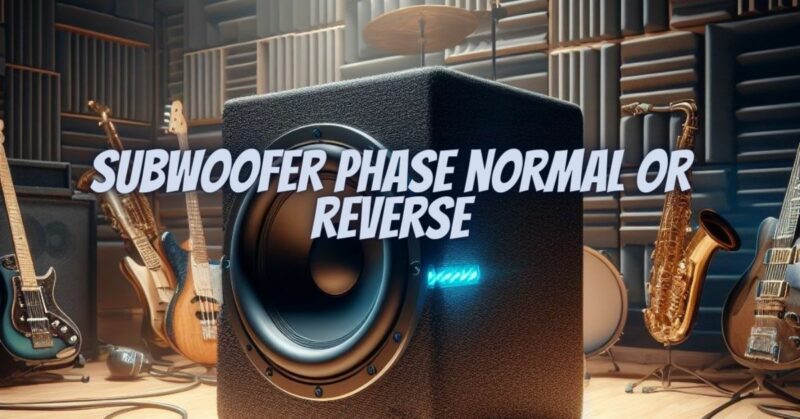In the quest for optimal audio performance in your home theater or audio system, one often encounters a perplexing choice: should you set your subwoofer’s phase to normal or reverse? This decision can profoundly affect the sound quality and integration of your subwoofer with the main speakers. In this comprehensive guide, we will explore the concept of subwoofer phase, why it matters, and how to determine whether to set it to normal or reverse for your specific audio setup.
Understanding Subwoofer Phase
In audio terminology, phase refers to the timing relationship between two or more sound waves. When we talk about subwoofer phase, we are essentially discussing how the subwoofer’s output aligns in time with the main speakers’ output. The two primary phase settings are “normal” and “reverse”:
- Normal Phase (0 degrees): In this setting, the subwoofer’s output is in-phase with the main speakers. This means that when the main speakers move outward to produce sound, the subwoofer’s cone moves outward as well, resulting in a reinforcement of low-frequency content.
- Reverse Phase (180 degrees): When set to reverse phase, the subwoofer’s output is out-of-phase with the main speakers. In this case, while the main speakers are moving outward to produce sound, the subwoofer’s cone moves inward, and vice versa. This setting is used to address issues of phase cancellation that may arise due to subwoofer and speaker placement.
Importance of Subwoofer Phase
The phase setting of your subwoofer is crucial for achieving coherent and unified sound across the entire frequency spectrum. Proper phase alignment ensures that the subwoofer and main speakers work together seamlessly, preventing destructive interference and enhancing bass response. Here’s why subwoofer phase is important:
- Frequency Alignment: By adjusting the phase, you can align the subwoofer’s output with the main speakers, ensuring that they work together to produce a more robust and impactful low-frequency response.
- Preventing Phase Cancellation: Phase cancellation occurs when sound waves from the subwoofer and main speakers interfere with each other, resulting in a loss of bass or uneven response. Adjusting the phase setting can help mitigate this issue.
- Room Acoustics: Different rooms have unique acoustical characteristics. Adjusting the subwoofer phase can compensate for room-related challenges, such as standing waves or uneven bass distribution.
- Speaker Compatibility: The phase setting can help tailor the subwoofer’s output to match the main speakers, especially when using different speaker models or brands in your system.
Setting Subwoofer Phase: Normal or Reverse
Determining whether to set your subwoofer phase to normal or reverse requires careful consideration of several factors, including room acoustics, subwoofer and speaker placement, and personal preferences. Here’s a comprehensive guide to help you make an informed decision:
- Assess Room Acoustics:
- Consider the acoustics of your room. Large, reflective spaces may be more prone to phase cancellation, making reverse phase a potential solution.
- Experiment with Subwoofer Placement:
- The placement of your subwoofer relative to the main speakers can significantly impact phase alignment. Adjust the subwoofer’s position while experimenting with phase settings to find the optimal balance.
- Consider Speaker Placement:
- Take into account the placement of your main speakers. If they are positioned close to a wall, corner, or other reflective surfaces, phase cancellation may be more likely, and reverse phase could help mitigate this issue.
- Use Room Calibration Tools:
- Many AV receivers and subwoofer processors come with room calibration systems that can automatically set the phase based on room measurements and speaker characteristics. Utilize these tools as a starting point and fine-tune if necessary.
- Listen Carefully:
- Ultimately, the most important factor is how the system sounds to your ears. Listen to a variety of audio content with both phase settings and trust your perception. Pay attention to the clarity and impact of the bass frequencies.
- Experiment:
- Feel free to experiment with both phase settings. There’s no one-size-fits-all solution, and the optimal setting may vary based on your unique room and speaker configuration.
- Manufacturer Recommendations:
- Refer to the specifications and recommendations provided by the manufacturers of your subwoofer and main speakers. They may offer guidance on phase settings based on the design of the components.
The choice between normal and reverse phase for your subwoofer is not a fixed decision but rather a dynamic parameter influenced by various factors, including room acoustics, speaker placement, and personal preferences. By understanding the role of phase in audio reproduction and taking a systematic approach to experimentation, you can find the ideal phase setting that maximizes the synergy between your subwoofer and main speakers. The goal is to achieve a seamless integration of low frequencies, resulting in a rich and immersive audio experience tailored to your specific listening environment. Whether you choose normal or reverse phase, the ultimate reward is a well-balanced and captivating soundstage that elevates your enjoyment of music, movies, and all forms of audio entertainment.


